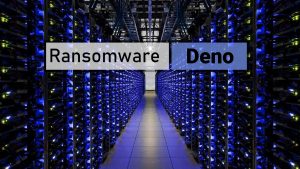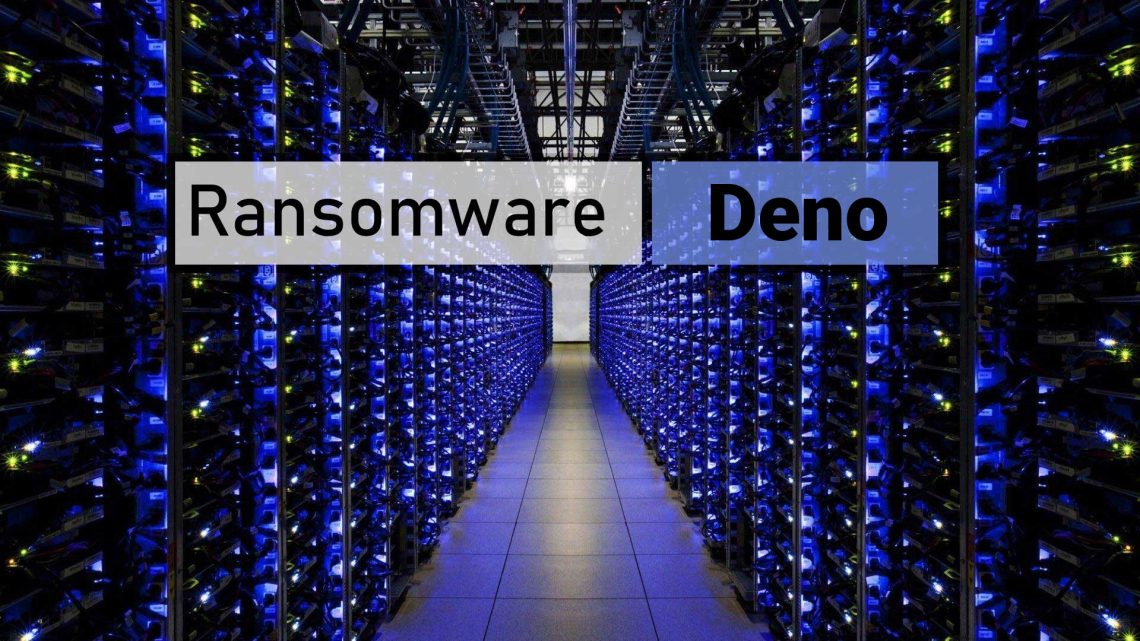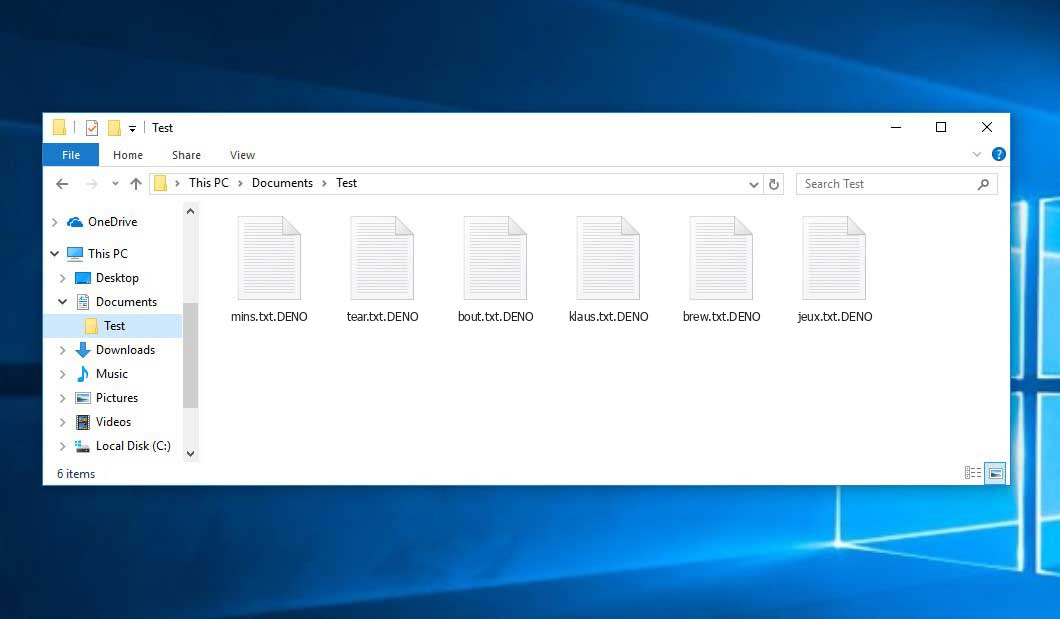The Deno virus belongs to the CONTI ransomware family. Harmful software of this type encrypts all user’s data on the computer (photos, text files, excel tables, audio files, videos, etc) and adds its extra extension to every file, creating the readme.txt files in every folder which contains the encrypted files.
Deno virus: what is known so far?
☝️ A strictly accurate description for the Deno would be “a CONTI family ransomware malicious agent”.
Deno will add its extra .DENO extension to every file’s title. For instance, a file named “photo.jpg” will be renamed to “photo.jpg.DENO”. In the same manner, the Excel sheet named “table.xlsx” will be renamed to “table.xlsx.DENO”, and so on.
In every directory containing the encoded files, a readme.txt file will appear. It is a ransom money memo. Therein you can find information on the ways of paying the ransom and some other information. The ransom note most probably contains instructions on how to buy the decryption tool from the tamperers. You can obtain this decrypting software after contacting flapalinta1950@protonmail.com, xersami@protonmail.com through email. That is it.
Deno abstract:
| Name | Deno Virus |
| Ransomware family1 | CONTI ransomware |
| Extension | .DENO |
| Ransomware note | readme.txt |
| Contact | flapalinta1950@protonmail.com, xersami@protonmail.com |
| Detection | MSIL/Injector.GBU, Win32/GenKryptik.FWOS, Worm:Win32/IRCbot.I |
| Symptoms | Your files (photos, videos, documents) have a .DENO extension and you can’t open them. |
| Fix Tool | See If Your System Has Been Affected by Deno virus |
The readme.txt document accompanying the Deno malware provides the following dispiriting information:
Your network is LOCKED. Do not try to use other software. For decryption KEY write HERE: flapalinta1950@protonmail.com xersami@protonmail.com
In the picture below, you can see what a directory with files encrypted by the Deno looks like. Each filename has the “.DENO” extension appended to it.
How did my machine catch Deno ransomware?
There are many possible ways of ransomware injection.
Nowadays, there are three most popular ways for malefactors to have ransomware acting in your digital environment. These are email spam, Trojan injection and peer-to-peer networks.
If you access your inbox and see letters that look just like notifications from utility services companies, postal agencies like FedEx, Internet providers, and whatnot, but whose mailer is unknown to you, be wary of opening those letters. They are very likely to have a harmful item enclosed in them. So it is even riskier to download any attachments that come with letters like these.
Another thing the hackers might try is a Trojan virus model2. A Trojan is an object that infiltrates into your computer disguised as something different. Imagine, you download an installer for some program you need or an update for some service. However, what is unboxed turns out to be a harmful agent that encodes your data. Since the update wizard can have any title and any icon, you’d better be sure that you can trust the source of the things you’re downloading. The optimal way is to use the software companies’ official websites.
As for the peer-to-peer networks like torrent trackers or eMule, the threat is that they are even more trust-based than the rest of the Web. You can never guess what you download until you get it. Our suggestion is that you use trustworthy websites. Also, it is a good idea to scan the folder containing the downloaded items with the anti-malware utility as soon as the downloading is complete.
How to remove the Deno virus?
It is crucial to inform you that besides encrypting your data, the Deno virus will most likely install the Azorult Spyware on your machine to get access to credentials to different accounts (including cryptocurrency wallets). The mentioned program can derive your logins and passwords from your browser’s auto-filling data.
Often racketeers would decrypt few of your files so you know that they indeed have the decryption program. Since Deno virus is a relatively new ransomware, anti-malware developers have not yet found a method to undo its work. However, the decoding instruments are constantly upgraded, so the effective countermeasure may soon be available.
Understandably, if the evildoers succeed in encoding victim’s critical data, the desperate person will most likely fulfill their demands. Nevertheless, paying to criminals gives no guarantee that you’re getting your blocked information back. It is still dangerous. After obtaining the money, the racketeers may send a wrong decryption key to the injured party. There were reports about hackers just vanishing after getting the money without even writing back.
The optimal solution against ransomware is to have a system restore point or the copies of your critical files in the cloud drive or at least on an external storage. Surely, that might be insufficient. Your most crucial thing could be that one you were working on when it all went down. But at least it is something. It is also reasonable to scan your drives with the antivirus program after the system restoration.
There are other ransomware products, besides Deno, that work similarly. Examples of those are Bbyy, Bbzz, Bnrs, and some others. The two basic differences between them and the Deno are the ransom amount and the method of encryption. The rest is the same: files become inaccessible, their extensions changed, ransom notes are created in each directory containing encrypted files.
Some lucky people were able to decode the blocked files with the help of the free tools provided by anti-ransomware experts. Sometimes the hackers mistakenly send the decryption key to the victims in the ransom readme. Such an extraordinary fail allows the victim to restore the files. But naturally, one should never rely on such a chance. Remember, ransomware is a tamperers’ tool to pull the money out of their victims.
How to avoid ransomware infection?
Deno ransomware doesn’t have a endless power, so as any similar malware.
You can defend your computer from ransomware attack in three easy steps:
- Never open any letters from unknown mailers with unknown addresses, or with content that has nothing to do with something you are waiting for (how can you win in a lottery without even taking part in it?). In case the email subject is likely something you are waiting for, check all elements of the dubious email with caution. A fake email will surely have a mistake.
- Do not use cracked or untrusted software. Trojans are often spreaded as an element of cracked software, possibly under the guise of “patch” preventing the license check. But untrusted programs are very hard to tell from reliable ones, as trojans sometimes have the functionality you seek. You can try searching for information about this program on the anti-malware message boards, but the best solution is not to use such programs at all.
- And to be sure about the safety of the files you downloaded, scan them with GridinSoft Anti-Malware. This software will be a powerful defense for your PC.
Reasons why I would recommend GridinSoft3
There is no better way to recognize, remove and prevent ransomware than to use an anti-malware software from GridinSoft4.
Download Removal Tool.
You can download GridinSoft Anti-Malware by clicking the button below:
Run the setup file.
When setup file has finished downloading, double-click on the setup-antimalware-fix.exe file to install GridinSoft Anti-Malware on your system.

An User Account Control asking you about to allow GridinSoft Anti-Malware to make changes to your device. So, you should click “Yes” to continue with the installation.

Press “Install” button.

Once installed, Anti-Malware will automatically run.

Wait for the Anti-Malware scan to complete.
GridinSoft Anti-Malware will automatically start scanning your system for Deno infections and other malicious programs. This process can take a 20-30 minutes, so I suggest you periodically check on the status of the scan process.

Click on “Clean Now”.
When the scan has finished, you will see the list of infections that GridinSoft Anti-Malware has detected. To remove them click on the “Clean Now” button in right corner.

FAQ
🤔 How can I open “.DENO” files?Is it possible to open“.DENO” files?
Negative. That is why ransomware is so frustrating. Until you decode the “.DENO” files you will not be able to access them.
🤔 The encrypted files are very important to me. How can I decrypt them quickly?
It’s good if you have fаr-sightedly saved copies of these important files elsewhere. Otherwise, you might try to employ System Restore. The only question is whether you have saved any Restore Points that would be helpful now. The rest of the methods require patience.
🤔 You have advised using GridinSoft Anti-Malware to get rid of the Deno virus. Does it mean that all my files, currently encrypted, will be removed too?
Of course not. The encrypted files are not harmful, so they won’t be deleted.
GridinSoft Anti-Malware only deals with real viruses. The virus that has attacked your PC is most likely still functional and launching checks from time to time to arrest any new files you might create on your computer after the attack. As it has been mentioned above, the Deno virus comes with the company. It installs backdoors and keyloggers that can take your account passwords by trespass and provide hackers with easy access to your computer after some time.
🤔 What should I do if the Deno malware has blocked my PC and I can’t get the activation code.
In such a case, you need to have a flash memory card with a previously installed Trojan Killer. Use Safe Mode to perform the cleaning. The point is that the ransomware starts automatically as the system launches and encodes any new files created or imported into your machine. To suppress this process – use Safe Mode, which allows only the vital applications to run automatically. Consider reading our manual on booting Windows in Safe Mode.
🤔 What could help the situation right now?
Some of the encrypted files can be located elsewhere.
- If you sent or received your critical files through email, you could still download them from your online mail server.
- You may have shared photographs or videos with your friends or relatives. Simply ask them to send those images back to you.
- If you have initially downloaded any of your files from the Web, you can try to do it again.
- Your messengers, social media pages, and cloud storage might have all those files too.
- Maybe you still have the needed files on your old computer, a portable device, cellphone, flash memory, etc.
HINT: You can employ data recovery utilities5 to get your lost data back since ransomware arrests the copies of your files, removing the authentic ones. In the tutorial below, you can see how to recover your files with PhotoRec, but remember: you won’t be able to do it before you remove the virus with an anti-malware program.
Also, you can contact the following official fraud and scam sites to report this attack:
- In the United States: On Guard Online;
- In Canada: Canadian Anti-Fraud Centre;
- In the United Kingdom: Action Fraud;
- In Australia: SCAMwatch;
- In New Zealand: Consumer Affairs Scams;
- In France: Agence nationale de la sécurité des systèmes d’information;
- In Germany: Bundesamt für Sicherheit in der Informationstechnik;
- In Ireland: An Garda Síochána;
To report the attack, you can contact local executive boards. For instance, if you live in USA, you can have a talk with FBI Local field office, IC3 or Secret Service.
I need your help to share this article.
It is your turn to help other people. I have written this article to help users like you. You can use the buttons below to share this on your favorite social media Facebook, Twitter, or Reddit.
Brendan SmithHow to Remove DENO Ransomware & Recover PC

Name: DENO Virus
Description: DENO Virus is a ransomware-type infections. This virus encrypts important personal files (video, photos, documents). The encrypted files can be tracked by a specific .DENO extension. So, you can't use them at all.
Operating System: Windows
Application Category: Virus
User Review
( votes)References
- My files are encrypted by ransomware, what should I do now?
- You can read more on Trojans, their use and types in the Trojan-dedicated section of GridinSoft official website.
- GridinSoft Anti-Malware Review from HowToFix site: https://howtofix.guide/gridinsoft-anti-malware/
- More information about GridinSoft products: https://gridinsoft.com/comparison
- Here are Top 10 Data Recovery Software Of 2023.



